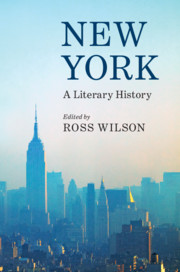Book contents
- New York: A Literary History
- New York
- Copyright page
- Contents
- Contributors
- Acknowledgements
- Chapter 1 Introduction
- Part I Adaptation and Adjustment
- Part II Innovation and Inspiration
- Part III Identity and Place
- Chapter 10 Growing Up in Manhattan
- Chapter 11 Wartime Reading in the City, 1914–1918
- Chapter 12 The Periodical and the Flâneur in Early New York Writing
- Chapter 13 Multiple Voices
- Chapter 14 The New York School?
- Part IV Tragedy and Hope
- Bibliography
- Index
Chapter 12 - The Periodical and the Flâneur in Early New York Writing
from Part III - Identity and Place
Published online by Cambridge University Press: 19 February 2020
- New York: A Literary History
- New York
- Copyright page
- Contents
- Contributors
- Acknowledgements
- Chapter 1 Introduction
- Part I Adaptation and Adjustment
- Part II Innovation and Inspiration
- Part III Identity and Place
- Chapter 10 Growing Up in Manhattan
- Chapter 11 Wartime Reading in the City, 1914–1918
- Chapter 12 The Periodical and the Flâneur in Early New York Writing
- Chapter 13 Multiple Voices
- Chapter 14 The New York School?
- Part IV Tragedy and Hope
- Bibliography
- Index
Summary
Emerging in the latter decades of the 18th century, New York periodical literature established and maintained a major relationship with the city and its people over the course of major historical, social, political, and cultural change. During this period, New York was one part of a literary triumvirate with Philadelphia and Boston in which periodical writing flourished. This periodical power soon shifted, however, to New York, with the founding of the New-York Magazine; or, Literary Repository (1790) by brothers Thomas and James Swords. The New–York Magazine preceded one of the most influential periodical publications in the history of New York writing by over a quarter of a century: the Knickerbocker (1833). New York was quickly becoming the centre of the American publishing world and the periodical was at the heart of this literary uprising. But, as this chapter argues, New York periodical literature first demonstrated its influence on New York society decades before in the final years of the 18th century.
- Type
- Chapter
- Information
- New YorkA Literary History, pp. 165 - 179Publisher: Cambridge University PressPrint publication year: 2020

